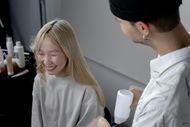One of the most common services sought in a salon is hair treatment. Keratin vs. rebonding offers two choices for straight, frizz-free hair. While multiple hair-straightening tools are available on the market, they offer only a short-term solution that lasts for a couple of days.
Hair treatments like keratin and bonding offer a relatively longer solution for frizzy and dry hair. Managing unruly tresses can be difficult, especially during a busy and demanding routine. A common confusion is how keratin and rebonding work and which suits your hair. This article addresses the major differences between the two and their pros and cons.

What is Keratin treatment?

Keratin is a natural protein that keeps hair and nails strong. However, this protective barrier can be damaged by multiple external and internal factors. The consequence? Frizzy, dry, and dull hair.
As the name suggests, keratin treatment involves the infusion of keratin using hair masks. Keratin does not change the hair structure but instead tries to rejuvenate the protective barrier.
What is rebonding?

Rebonding treatment is a chemical process that changes the structure of the hair. After applying the chemical, a hot iron is used to straighten your hair. However, your new hair grows out of its original texture. The process can take up to 5 hours before your hair is fully set.
Keratin vs rebonding: Exploring the pros and cons of hair treatments

A comparative view of both treatments can help determine which option works best for you. It might be important to consider that both treatments are artificial, and neither is a long-term solution for smooth and straight hair.
Beauty trends, including hair treatments, are constantly evolving. One factor impacting these trends is the general perception of what is considered beautiful. For a long time, straight and smooth hair has been the prototype of beautiful hair, but the narrative is slowly changing. Beauty movements have become more inclusive and focused on retaining the original hair quality.
Which hair treatment would you go with? Tell us in the comments below.
